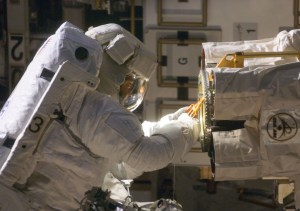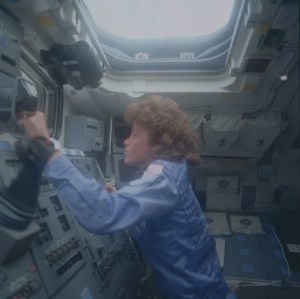The third Moon landing mission began on Jan. 31, 1971, with the launch of Apollo 14. A giant Saturn V rocket lifted off from Launch Pad 39A at NASA’s Kennedy Space Center (KSC) with the crew of Commander Alan B. Shepard, Command Module Pilot Stuart A. Roosa, and Lunar Module Pilot Edgar D. Mitchell strapped inside their capsule. Engineers had modified the spacecraft to prevent a recurrence of the accident that crippled Apollo 13 the previous year. After their Saturn V rocket delivered them into a parking orbit around the Earth, the third stage reignited to send them on their way to the Moon. Overcoming difficulties in docking with their Lunar Module (LM), Shepard, Roosa, and Mitchell began the three-day coast to the Moon, arriving in lunar orbit on Feb. 4 to prepare for the landing in and exploration of the Fra Mauro highlands.
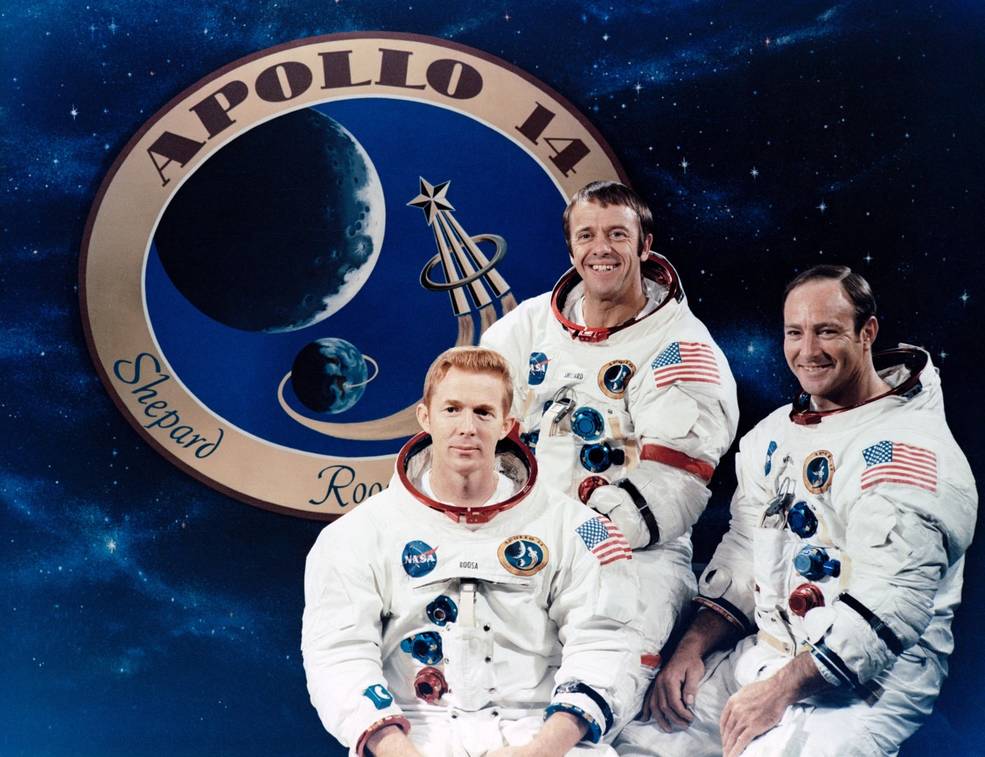
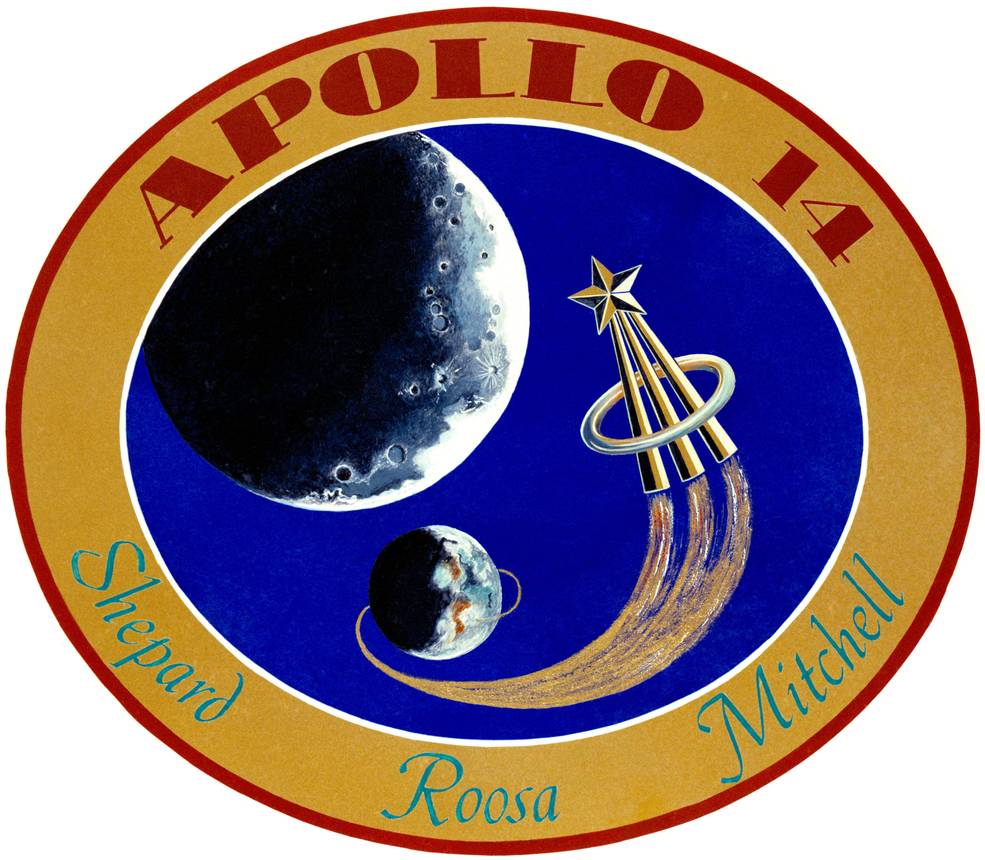
Left: The Apollo 14 crew of Stuart A. Roosa, left, Alan B. Shepard, and Edgar D. Mitchell. Right: The Apollo 14 crew patch.
The terminal countdown for Apollo 14’s launch began on Jan. 29 and proceeded without any technical issues. Engineers in Firing Room 2 of KSC’s Launch Control Center (LCC) monitored all aspects of the countdown, including the final fueling of the Saturn V rocket. Shepard, Roosa, and Mitchell ate their traditional steak and eggs breakfast before putting on their spacesuits and taking the Astrovan to Launch Pad 39A, where they boarded their spacecraft, the Command Module Kitty Hawk. Shepard took the left-hand seat, Roosa the middle, and Mitchell the right. Thousands of spectators assembled along the beaches near KSC to view the launch. In the viewing stands, Vice President Spiro T. Agnew, accompanied by NASA astronaut Neil A. Armstrong, hosted Prince Juan Carlos and Princess Sofía of Spain.
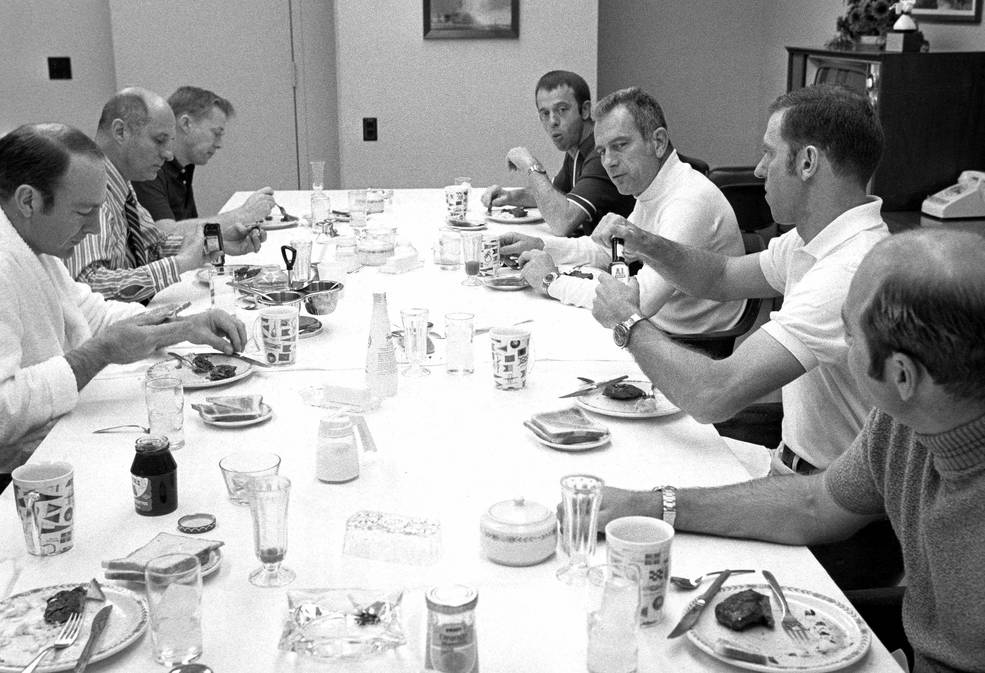
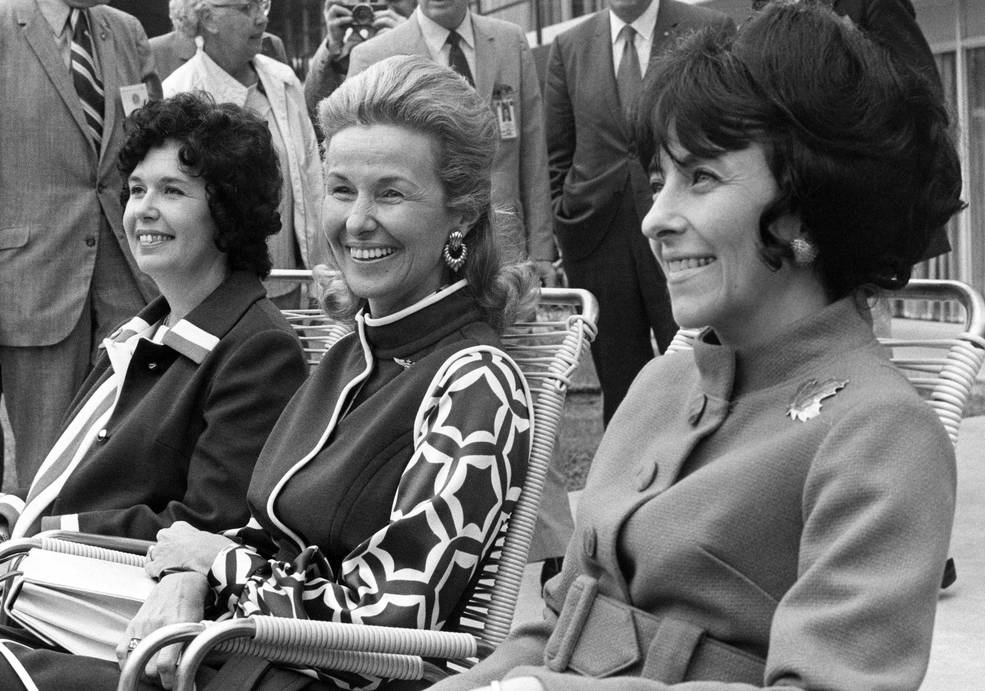
Left: At the traditional prelaunch breakfast are Edgar D. Mitchell, left, Chief of the Astronaut Office Thomas P. Stafford, Stuart A. Roosa, Alan B. Shepard, Chief of Flight Crew Operations Donald K. “Deke” Slayton, backup Apollo 14 Lunar Module Pilot Joe H. Engle, and backup Apollo 14 Command Module Pilot Ronald E. Evans. Right: The wives of the Apollo 14 astronauts Joan Roosa, left, Louise Shepard, and Louise Mitchell relax a few hours before the launch
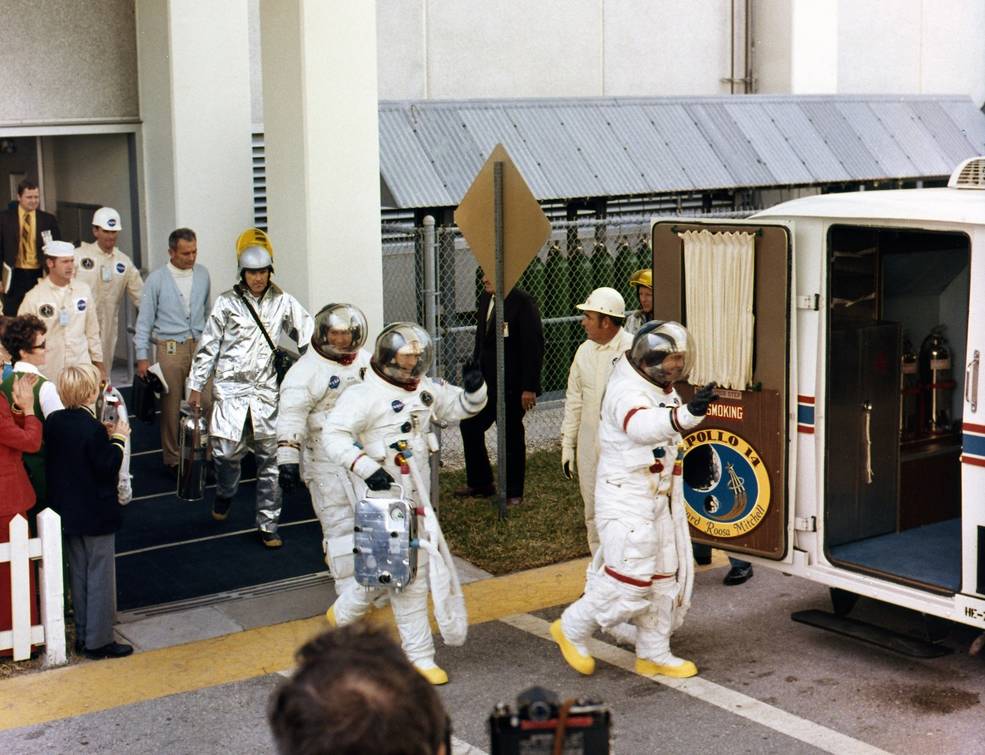
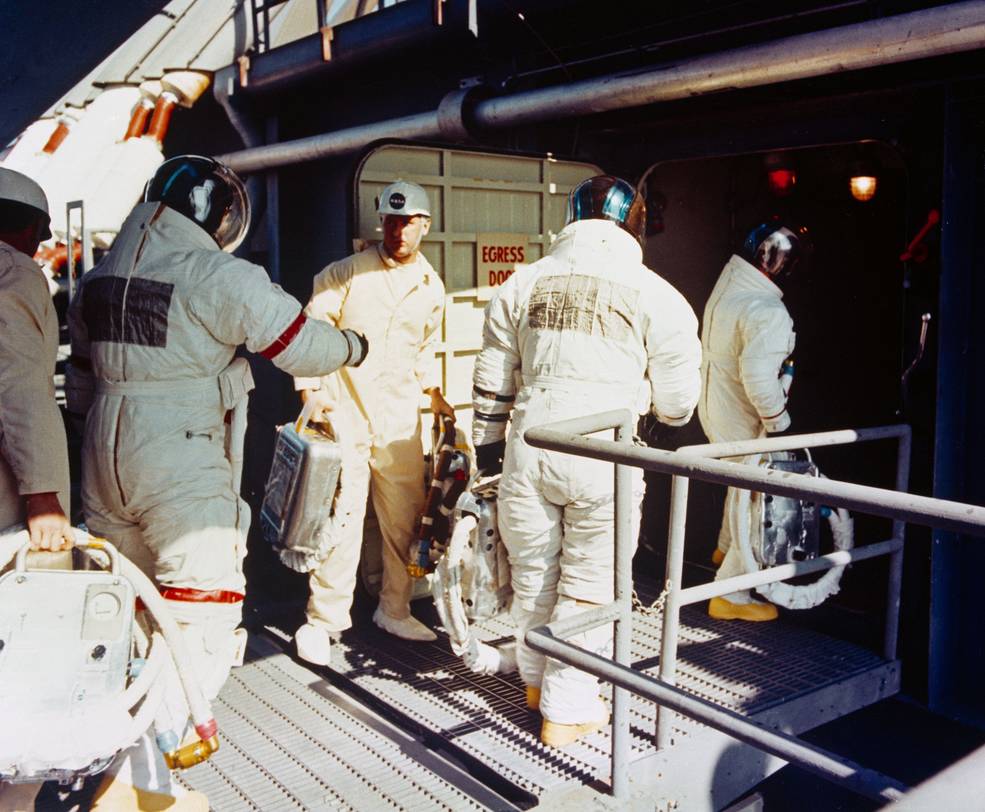
Left: Apollo 14 astronauts Edgar D. Mitchell, left, Stuart A. Roosa, and Alan B. Shepard about to board the Astrovan for the ride out to Launch Pad 39A. Right: At Launch Pad 39A, Apollo 14 astronauts Shepard, left, Mitchell, and Roosa enter the White Room to board their Command Module Kitty Hawk
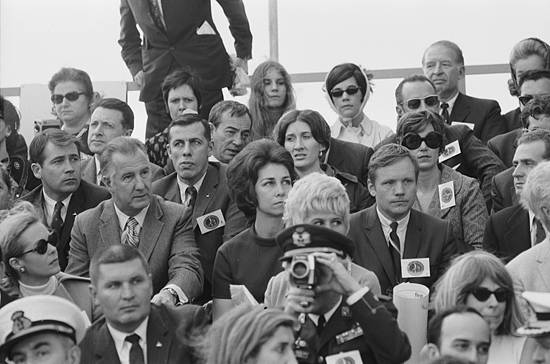
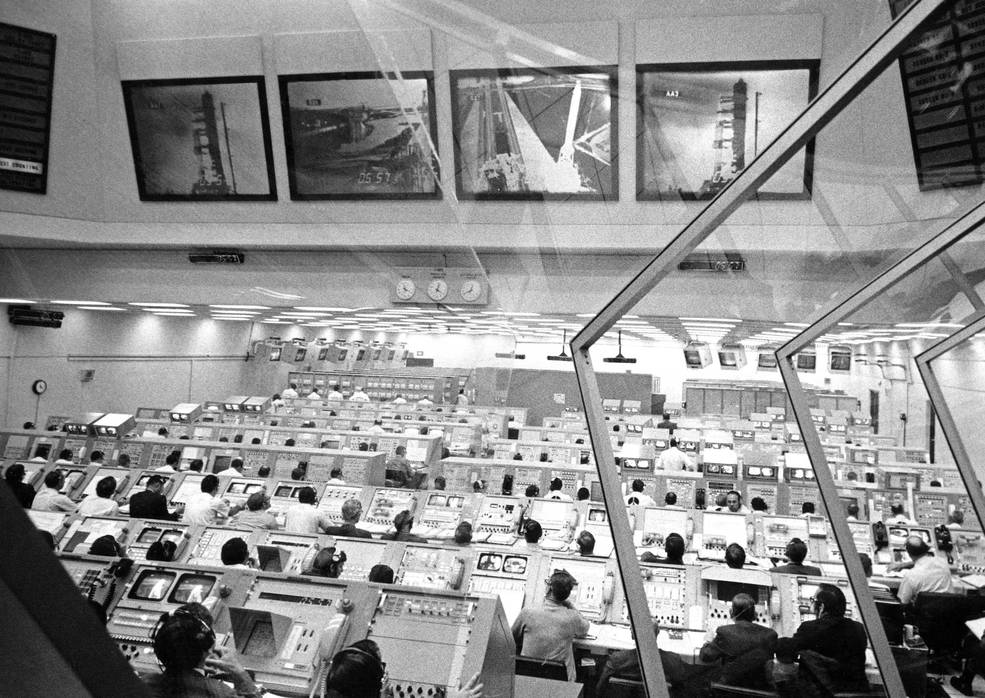
Left: In the viewing stands at NASA’s Kennedy Space Center (KSC), Vice President Spiro T. Agnew, Princess Sofía of Spain, NASA astronaut Neil A. Armstrong, and Prince Juan Carlos of Spain await the launch. Right: In Firing Room 2 of KSC’s Launch Control Center, engineers monitor the progress of the countdown.
In the final minutes of the countdown, a band of rain showers passed over KSC and delayed the launch by 40 minutes. Lift off finally came at 4:03 p.m. Eastern time on Jan. 31, 1971. The Saturn V rocket launched Apollo 14 into a cloudy afternoon sky. Ten seconds after the first motion, the rocket cleared the launch tower, and mission responsibility shifted from KSC’s Firing Room 2 to the Mission Control Center (MCC) at the Manned Spacecraft Center, now NASA’s Johnson Space Center in Houston. In the MCC, Flight Director M.P. “Pete” Frank led his Orange Team of controllers who monitored every aspect of the mission, with NASA astronaut C. Gordon Fullerton acting as capsule communicator (Capcom), the person who talked directly to the crew during the flight. After burning for 2 minutes and 44 seconds and lifting the rocket to an altitude of 40 miles, the first stage jettisoned, allowing the second stage engines to continue powering the ascent. During its six and a half minutes of operation, the second stage raised Apollo 14’s altitude to 117 miles and increased its velocity to more than 15,600 miles per hour, nearly enough to achieve orbit. At that point, the rocket’s third stage took over, firing for a little over two minutes to place Apollo 14 into a circular 117-mile-high parking orbit around the Earth.
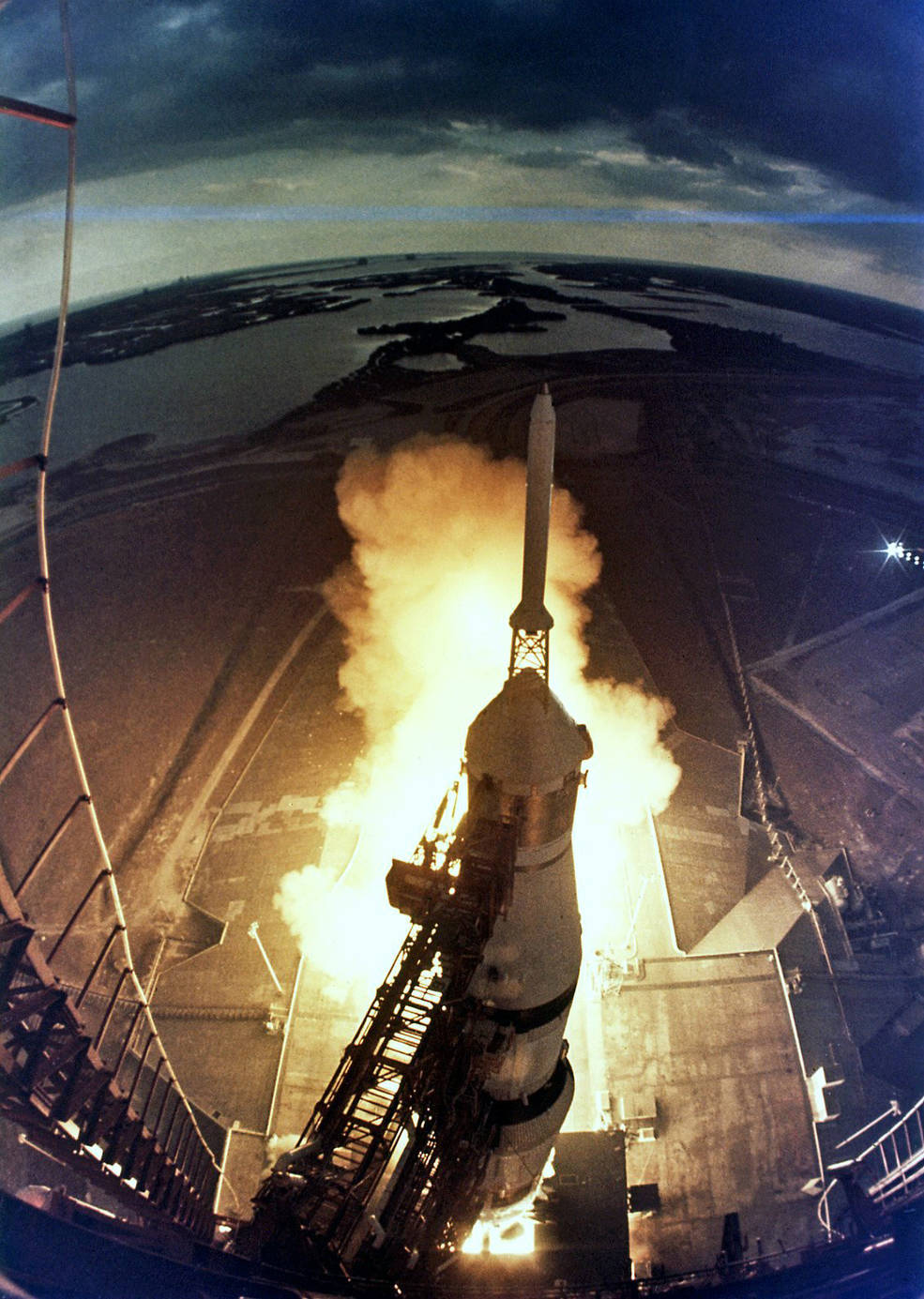
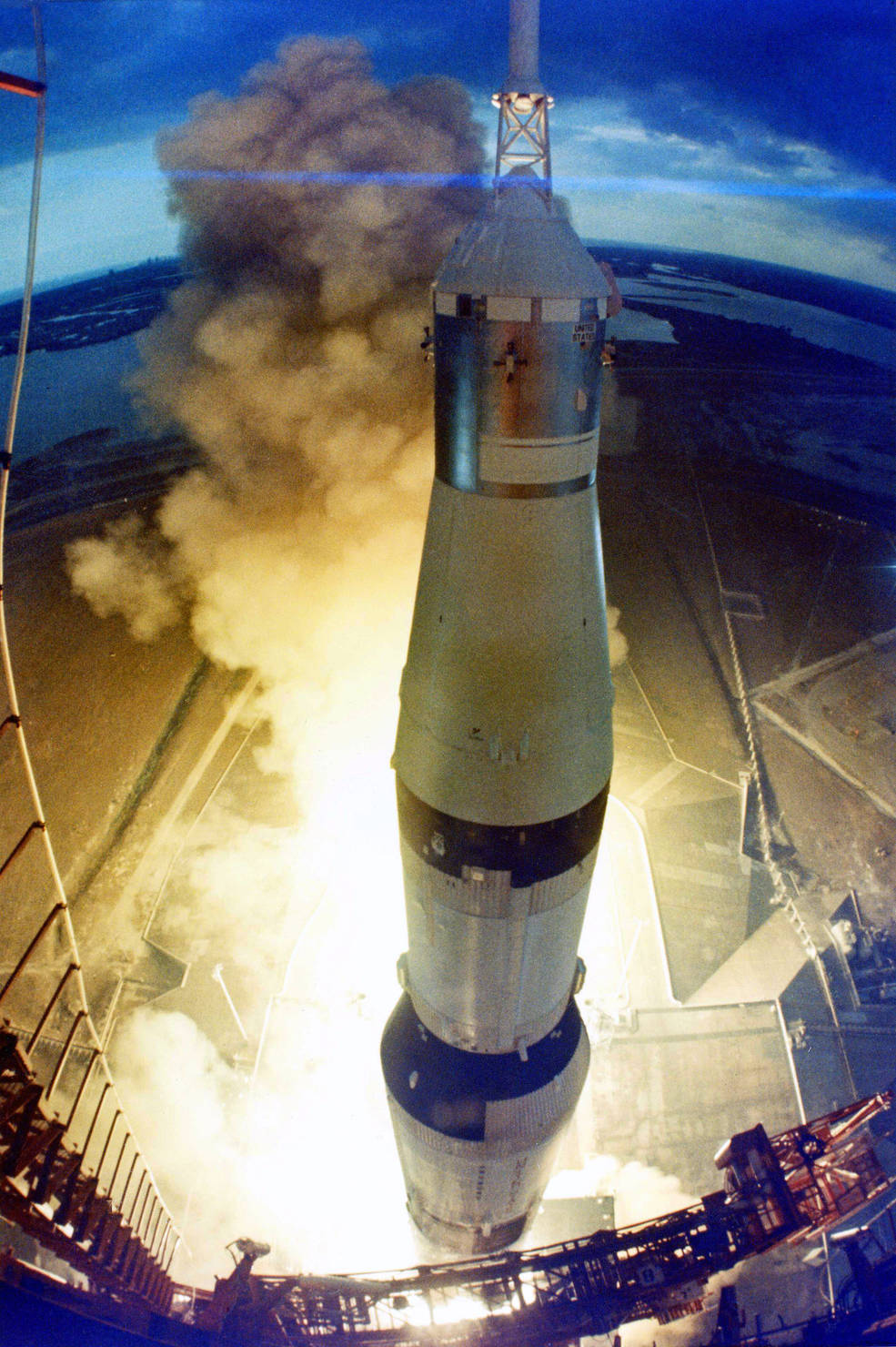
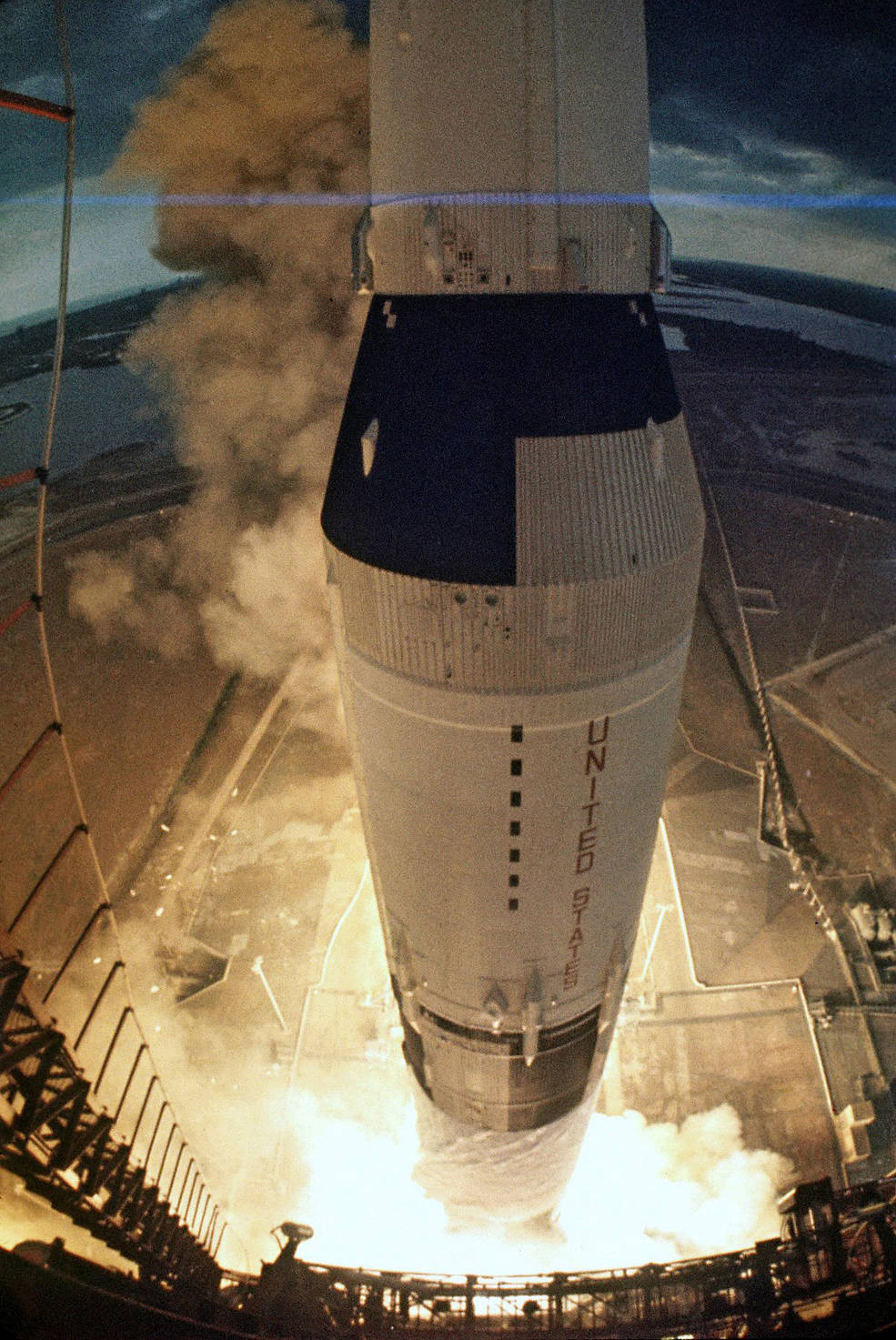
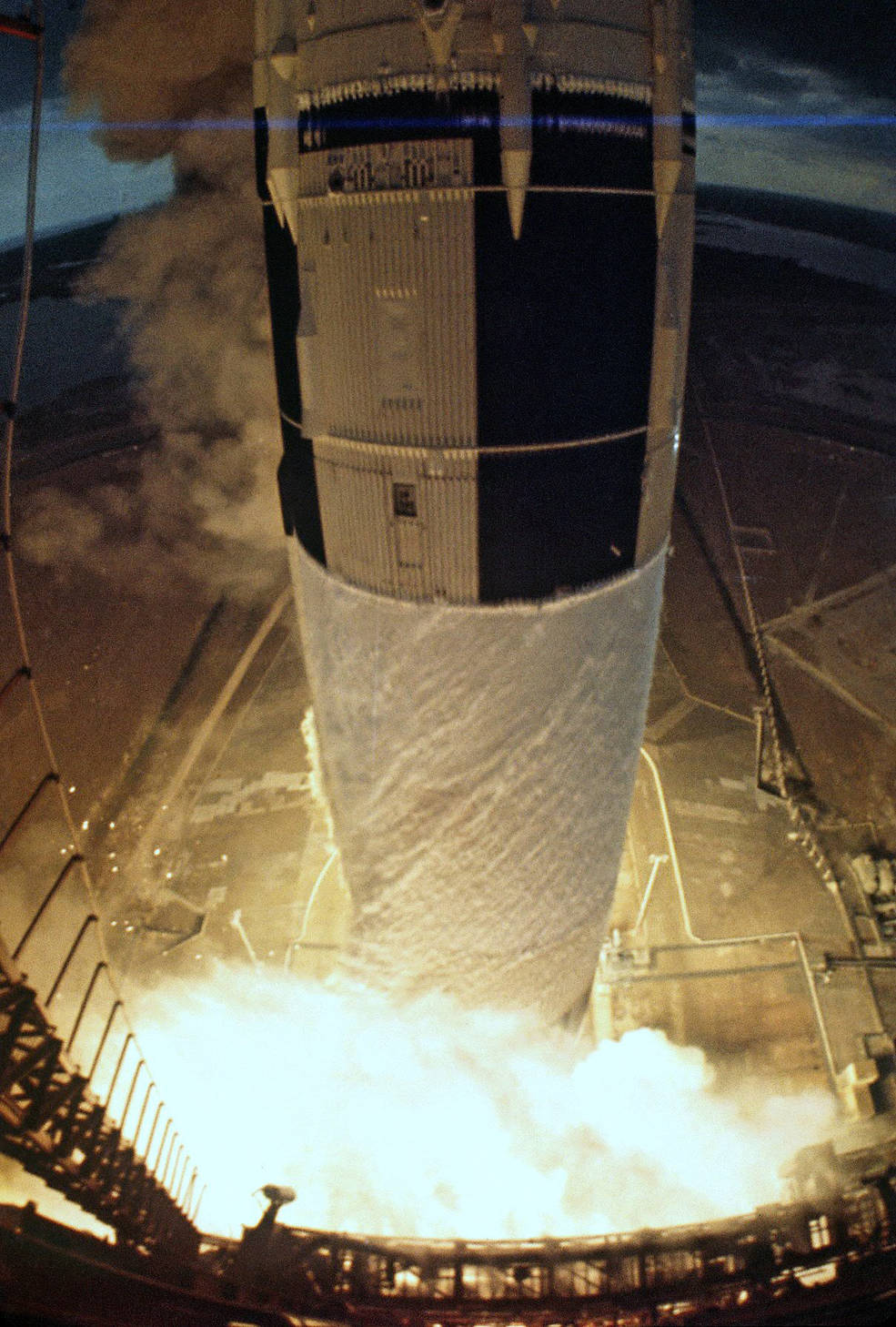
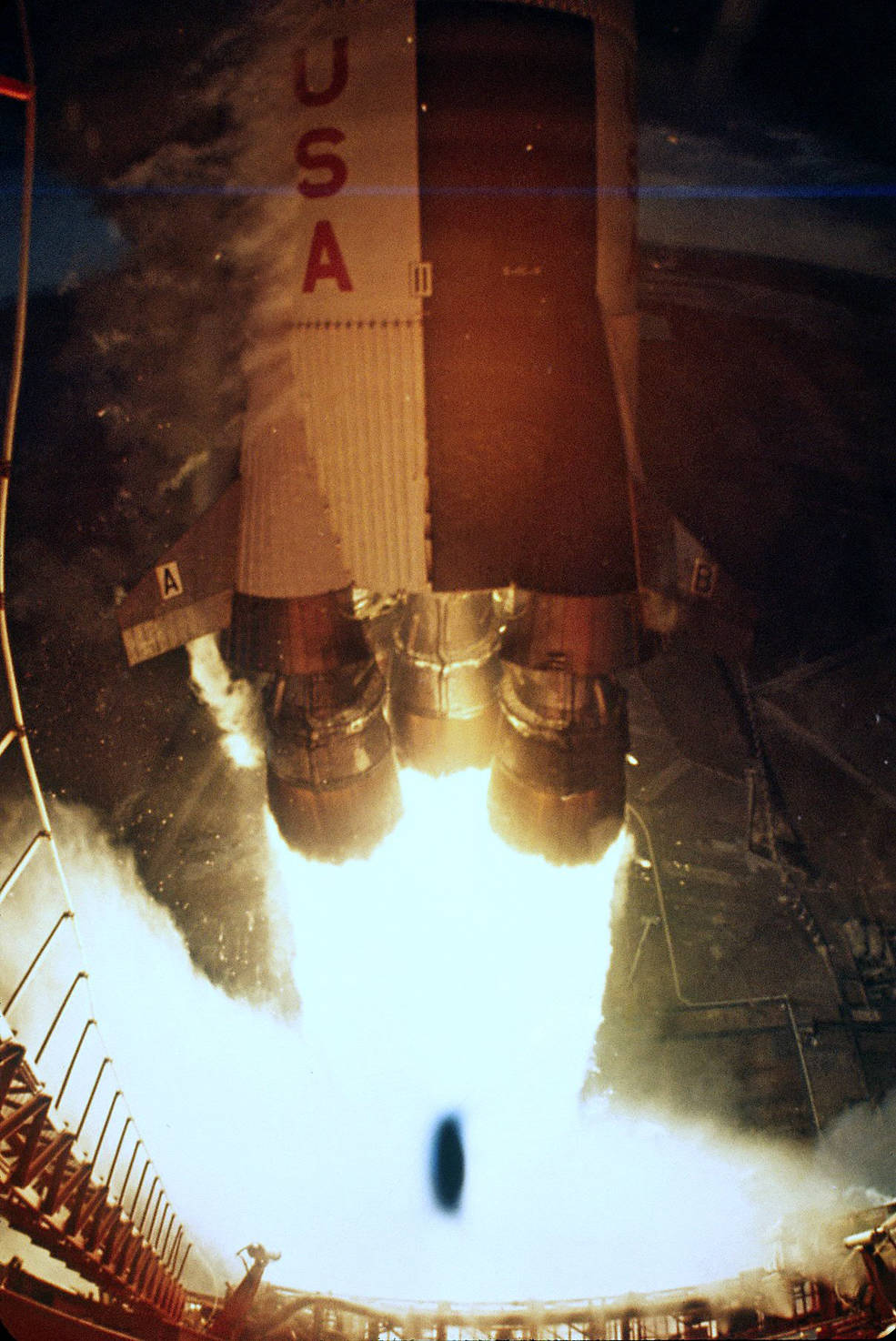
Sequential views of the liftoff of Apollo 14 taken by a camera on the launch umbilical tower.
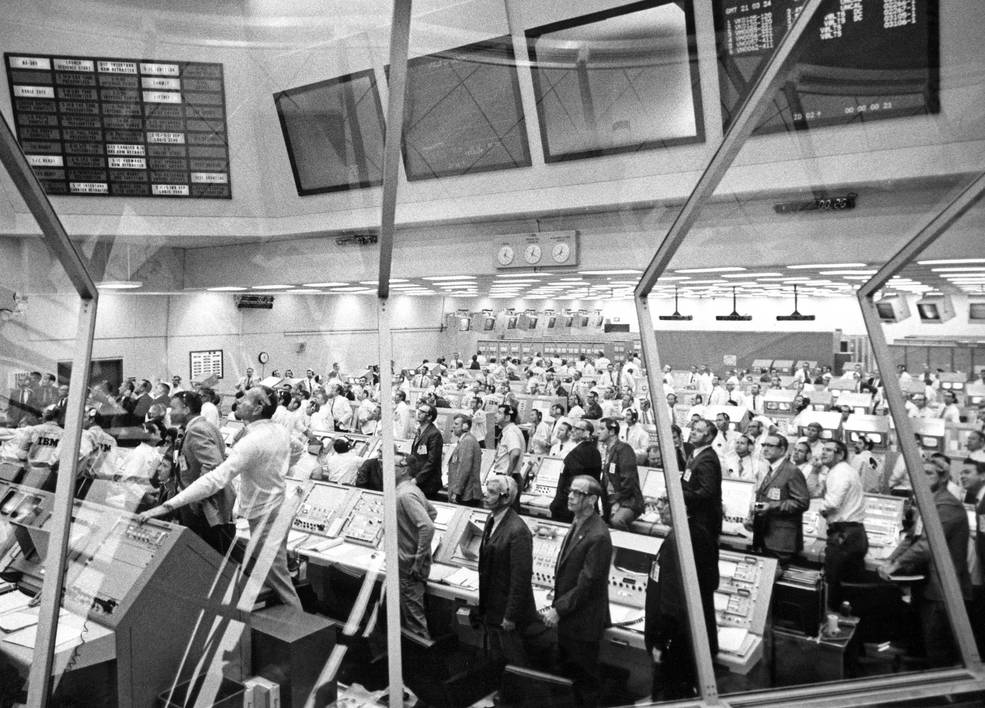
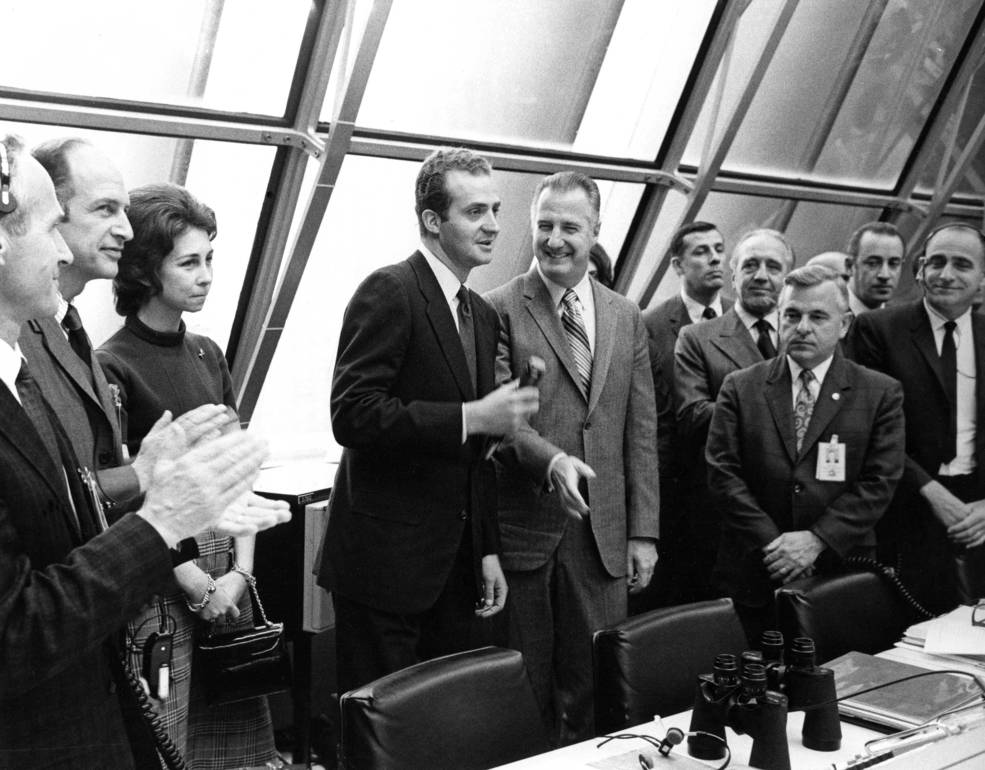
Left: After the Saturn V rocket cleared the tower, engineers in Firing Room 2 of the Launch Control Center (LCC) at NASA’s Kennedy Space Center watch the liftoff of Apollo 14. Right: Prince Juan Carlos of Spain holding a microphone, center, accompanied by Princess Sofía, left, and Vice President Spiro T. Agnew, congratulates the team in the LCC after the successful launch.
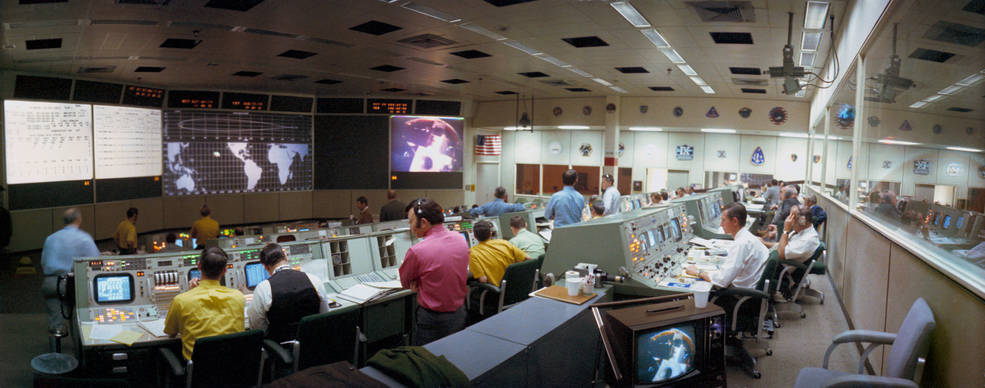
View of the Mission Control Center at the Manned Spacecraft Center, now NASA’s Johnson Space Center in Houston, during the Apollo 14 transposition and docking maneuver.
Over the next two and a half hours, Shepard, Roosa, and Mitchell checked the condition of their spacecraft, at the end of which Fullerton called to them, “You’re Go for the Moon. Go for TLI.” Shepard responded with, “Roger, Go for TLI,” both referring to the Trans-Lunar Injection, the second burn of the rocket’s third stage that accelerated them out of Earth orbit and on toward the Moon. The engine burned for 5 minutes and 52 seconds, increasing their velocity to 24,238 miles per hour, and raised the high point of their orbit to 288,000 miles that put them on a trajectory to reach a point near the Moon in three days’ time.
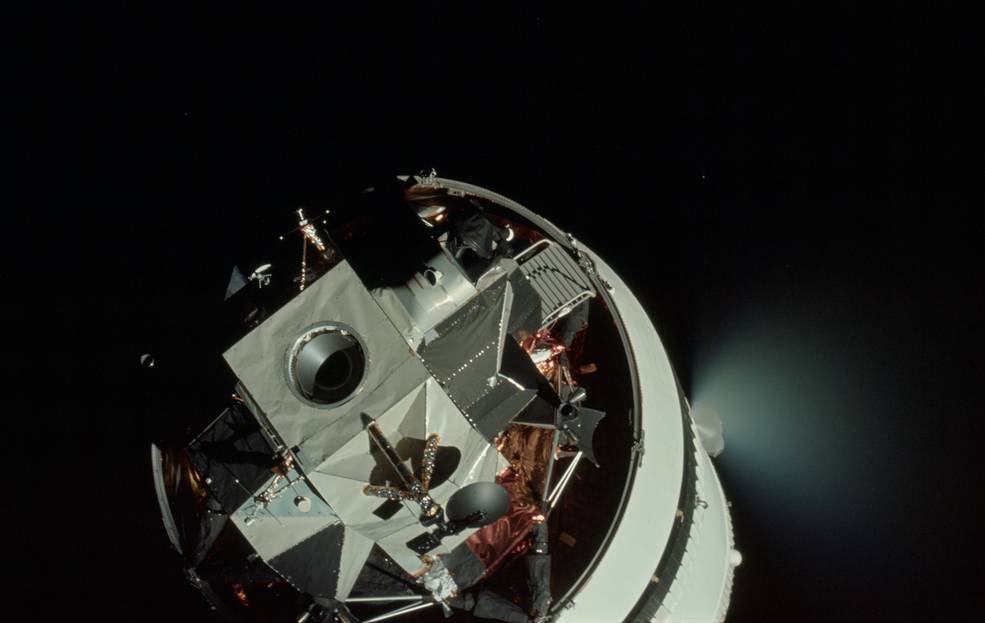
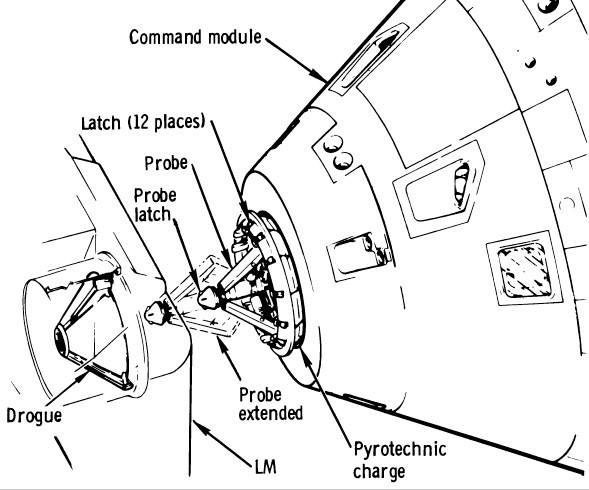
Left: The Apollo 14 Lunar Module Antares still attached to the Saturn V rocket’s third stage, that is venting leftover propellant. Right: Schematic view of the Apollo probe-and-drogue docking mechanism.
About 30 minutes after TLI, with Roosa at the controls of the spacecraft, the Apollo 14 astronauts began the transposition, docking, and extraction maneuver. First, they separated the Command and Service Module (CSM) Kitty Hawk from the third stage that held their LM Antares inside the four-paneled Spacecraft LM Adapter (SLA). The SLA panels opened like the petals of a flower and were jettisoned, allowing the CSM to turn around, dock with the LM, and extract it from the now spent third stage. The crew turned on a television camera for the controllers in the MCC to monitor the event. As Roosa brought the two spacecraft together for the docking, the three capture latches at the end of the probe failed to activate to achieve an initial soft docking, and the CSM began to drift back away from the LM. Roosa fired Kitty Hawk’s thrusters for a second docking attempt, but the latches failed to engage once again. He backed the CSM away and tried a third time, this time at a higher speed, but still the latches would not capture. Fullerton radioed up to have the crew check all the appropriate circuit breakers and try one more time, this time firing the thrusters after the contact to allow time for the latches to engage, but again the crew reported no success. Clearly, if they could not complete a docking with the LM, the Moon landing was in jeopardy.
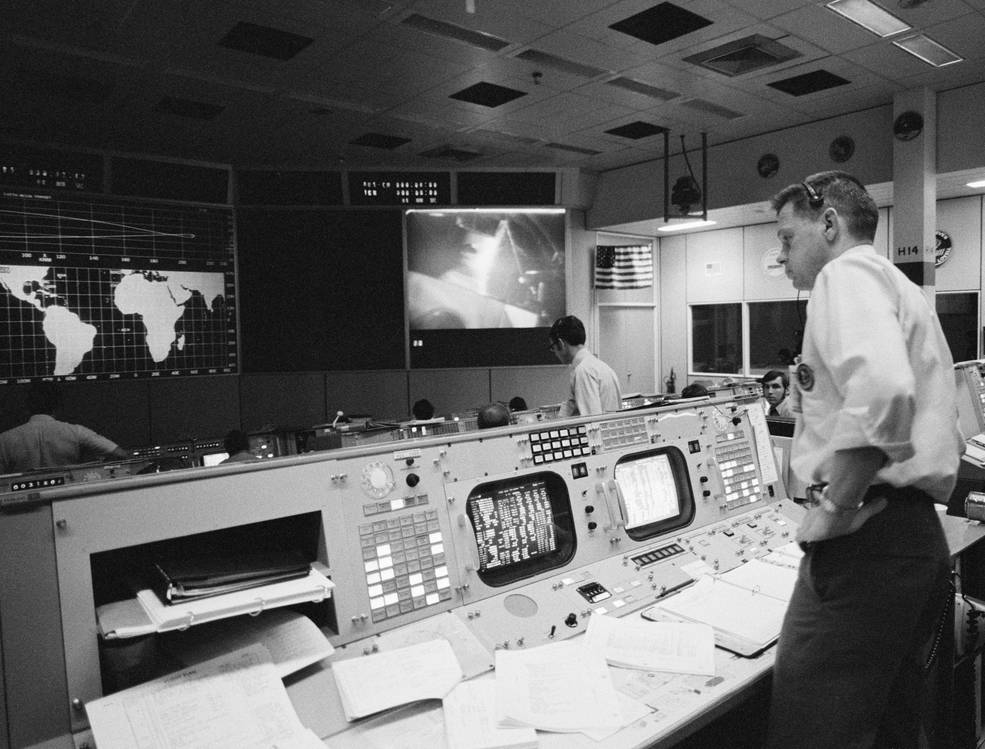
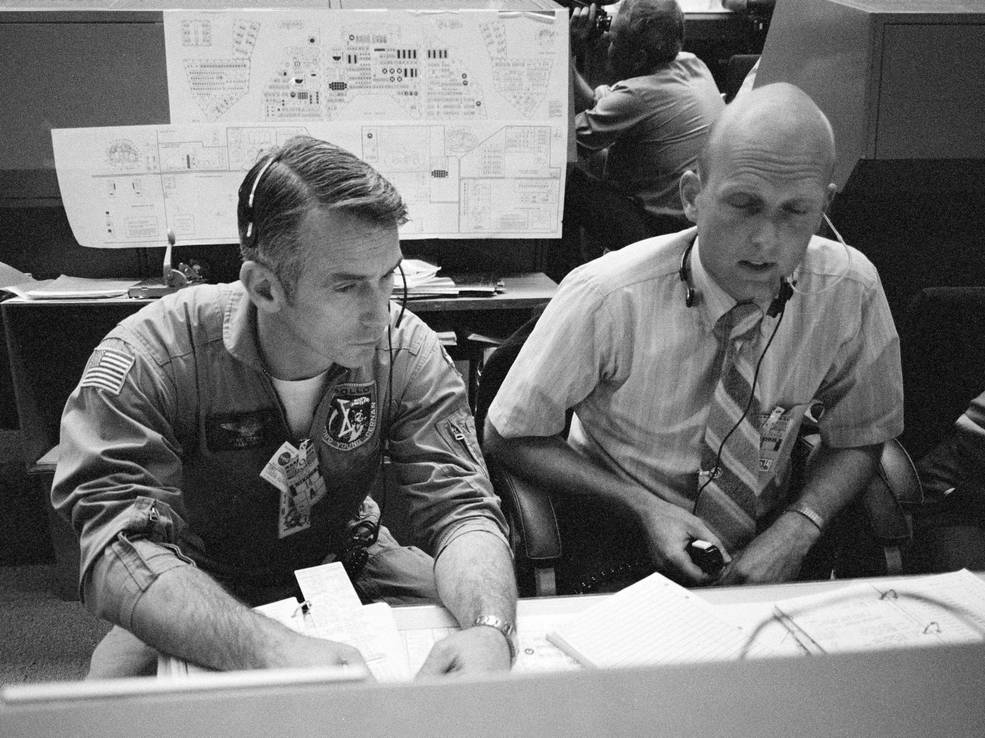
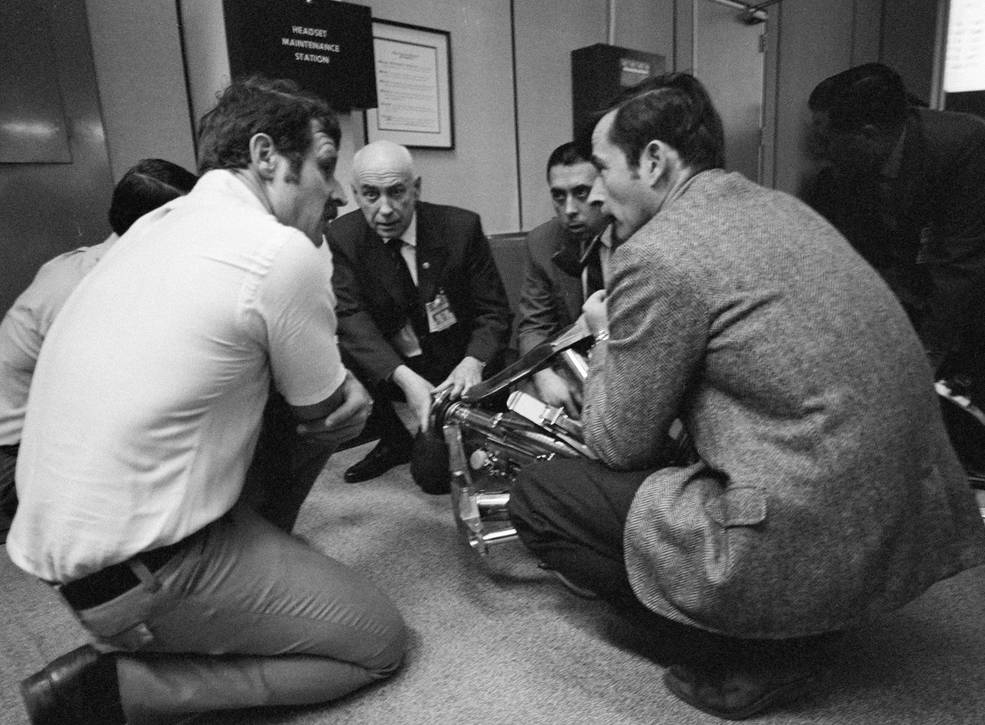
Left: In the Mission Control Center at the Manned Spacecraft Center (MSC), now NASA’s Johnson Space Center in Houston, Flight Director M.P. “Pete” Frank during the Apollo 14 transposition and docking maneuver. Middle: Apollo 14 backup commander Eugene A. Cernan assisting capsule communicator C. Gordon Fullerton during the Apollo 14 transposition and docking maneuver. Right: Flight Controller John S. Llewellyn uses a docking probe model to discuss the anomaly during the Apollo 14 docking with MSC Director Robert L. Gilruth, left, George W.S. Abbey, and astronaut John W. Young.
Engineers in the MCC continued to troubleshoot the problem, bringing a model of the docking system’s probe into the room. Fullerton recommended another docking attempt at normal speed and resetting the docking probe extend/retract switch. This fifth attempt also failed. For the next attempt, MCC advised the crew to come in for another docking, and once the probe was in the drogue to continue firing thrusters to keep the two vehicles together while simultaneously commanding the probe to retract, so that the 12 latches around the docking collar had a chance to achieve a hard docking. This sixth docking attempt succeeded, and Kitty Hawk and Antares became one spacecraft. By this time, Apollo 14 had reached an altitude of nearly 24,000 miles on its way toward the Moon.
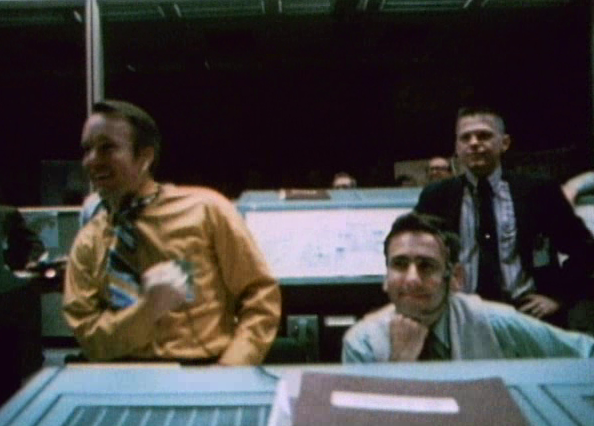
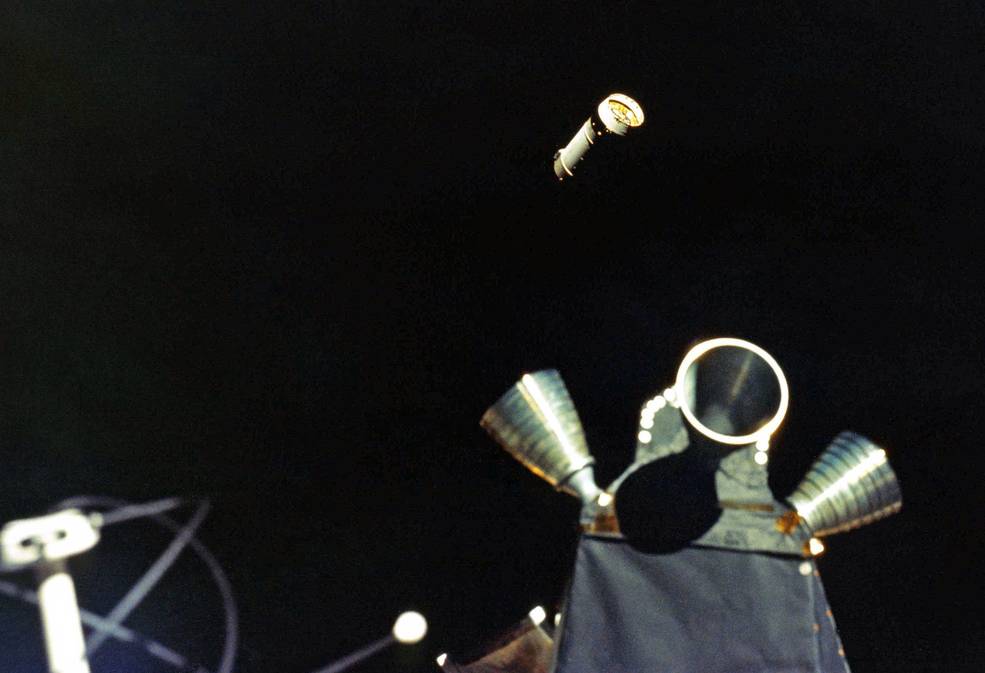
Left: Apollo 14 Flight Directors Gerald D. “Gerry” Griffin, left, Milton L. Windler, and M.P. “Pete” Frank cheer as docking is accomplished on the sixth attempt. Right: The Saturn V rocket’s spent third stage as it moves away from the docked Apollo 14 spacecraft.
Flight Director Milton L. Windler’s Maroon Team of controllers replaced Frank’s team in the MCC with that major problem solved. Bruce McCandless replaced Fullerton as the capcom. The crew aboard Apollo 14 checked the integrity of the docking mechanism, verifying that all 12 latches had closed. The astronauts began to pressurize Antares from Kitty Hawk and extracted it from the third stage. Controllers in the MCC commanded the now spent stage to conduct an evasive maneuver to avoid re-contacting the spacecraft, and ultimately sent it on a course to impact the Moon. The seismometer left on the lunar surface by Apollo 12 recorded the impact, with the Moon reverberating for more than three hours. Since the rocket had placed Apollo 14 on such a precise trajectory, mission controllers decided that the crew did not need to perform the first planned mid-course correction maneuver.
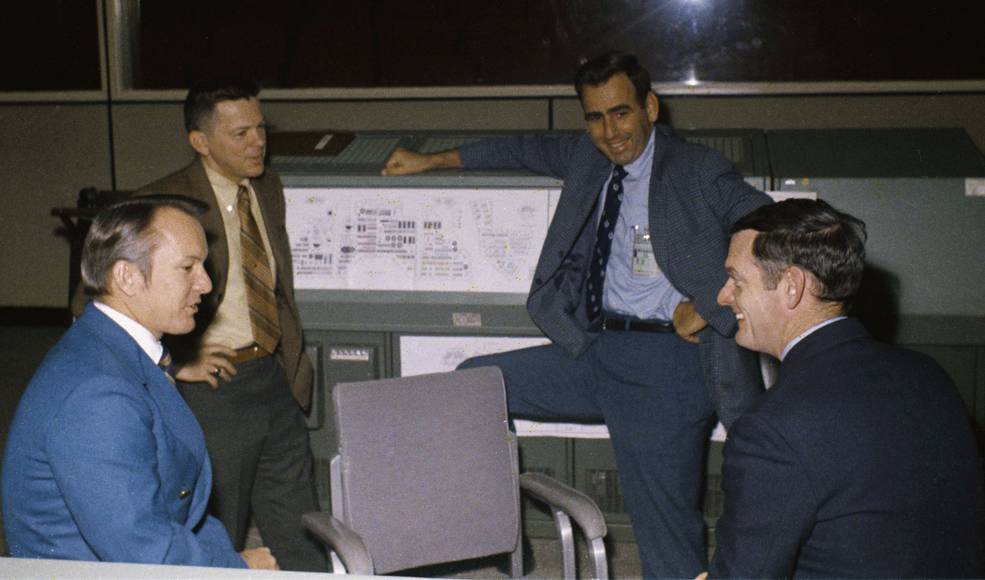
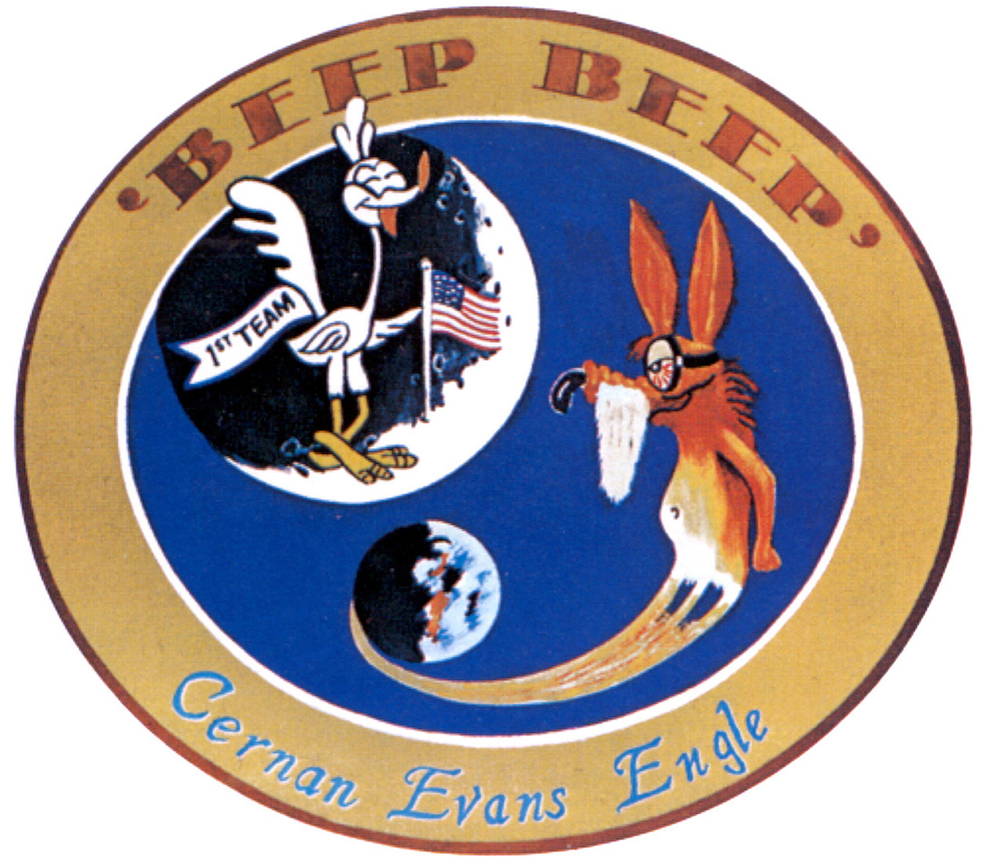
Left: Apollo 14 Flight Directors Gerald “Gerry” Griffin, left, M.P. “Pete” Frank, Milton L. Windler, and Glynn S. Lunney, in the Mission Control Center at the Manned Spacecraft Center, now NASA’s Johnson Space Center in Houston. Right: The patch designed by the Apollo 14 backup crew of Eugene A. Cernan, Ronald C. Evans, and Joe H. Engle, copies of which they surreptitiously placed around the spacecraft for the prime crew to find once in space.
The astronauts finally settled down to a meal, following which they removed and inspected the docking mechanism to investigate the cause of the problem. They broadcast live television so engineers in the MCC could assist in the process. Other than observing several scratches on the drogue, presumably made by the probe during the multiple docking attempts, they could find no obvious problems. The leading assumption was that debris that eventually dislodged prevented the first five docking attempts. Flight Director Gerald D. “Gerry” Griffin’s Gold Team of controllers took over from Windler’s team, with Fred W. Haise replacing McCandless as capcom. The astronauts placed their spacecraft in the passive thermal control attitude, also known as the barbecue mode, turning it along its long axis at the slow rate of three rotations per hour to equalize temperatures across the vehicle. After that, the crew began their first sleep period in space, concluding a very long day that began back in Florida that morning. They had reached a distance of 85,000 miles from Earth.
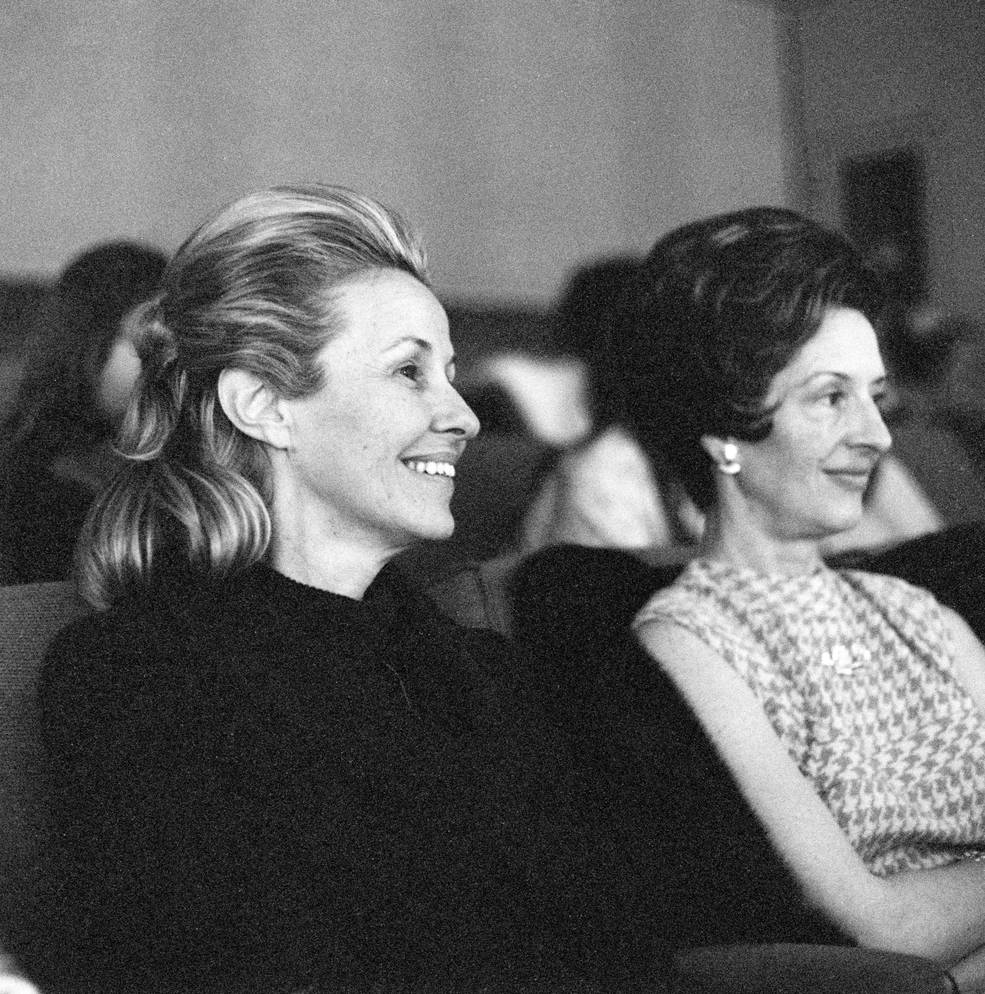
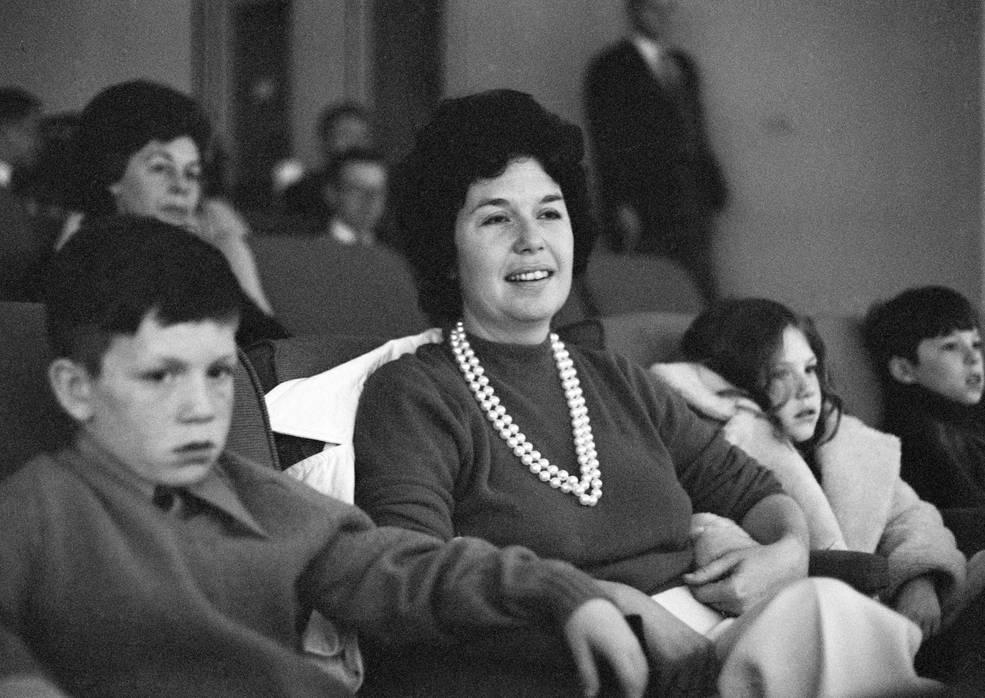
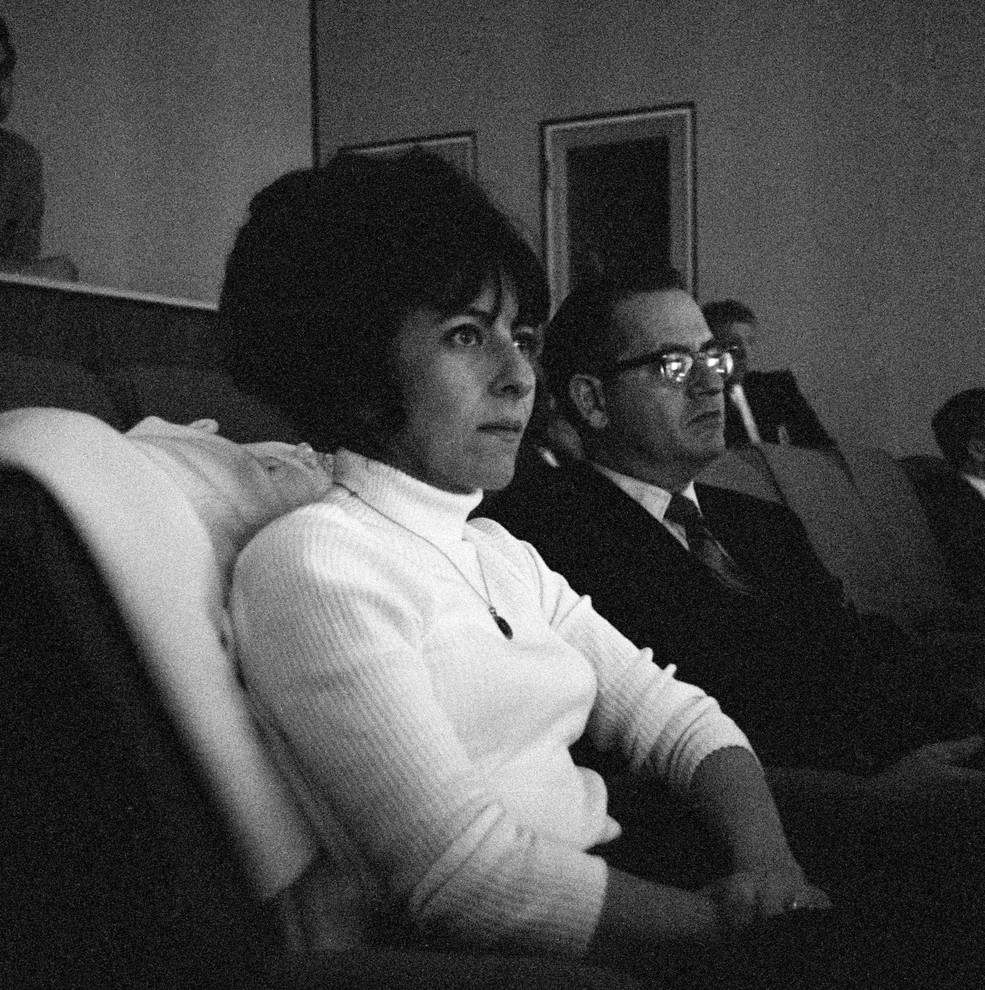
Left: Louise Shepard in the Visitor Gallery at the Mission Control Center (MCC) in the Manned Spacecraft Center, now NASA’s Johnson Space Center in Houston, during the flight of Apollo 14. Middle: Joan Roosa, center, with her children in the MCC Visitor Gallery. Right: Louise Mitchell, left, in the MCC Visitor Gallery.
Overnight, Frank’s team of controllers and Capcom Fullerton came back into the MCC to help the crew begin their second day in space, which was relatively quiet compared to their first day. Unmentioned, they passed the halfway point in distance between the Earth and the Moon. Day two’s main activity centered on performing the first midcourse correction of the flight, a 10-second burn using the Service Propulsion System (SPS) engine, to adjust their trajectory from their current free-return path to one best suited for the landing in the Fra Mauro highlands. The burn also corrected for the 40-minute launch delay, so they arrived in lunar orbit at the originally planned time and the proper distance of 77 miles. The primary activity on their third day in space, that they began 185,000 miles from Earth, involved pressurizing and powering up the LM Antares and conducting housekeeping activities such as checking out its life support and communications systems. The crew treated the ground to a 42-minute TV broadcast of their activities, with the astronauts’ families observing from the MCC’s Visitor Gallery. The only surprise the astronauts found in Antares, as they also found in Kitty Hawk, was a profusion of patches designed by the backup crew of Eugene A. Cernan, Ronald E. Evans, and Joe H. Engle, that they had secretly stashed in various places in both spacecraft before launch. Just as the astronauts started their sleep period at the end of the third day, Apollo 14 passed into the lunar sphere of influence and began accelerating toward its target.
Shepard, Roosa, and Mitchell’s fourth day in space began with a minor midcourse correction, a very short burst of the SPS engine of less than one second, to lower their approach altitude at the Moon to 69 miles. Then it was time for them to focus on preparing for the all-important Lunar Orbit Insertion (LOI) maneuver, a six-minute SPS engine burn to place them into orbit around the Moon. As on previous missions, this critical LOI burn took place behind the Moon, out of contact with the Earth, so at first, only the three astronauts aboard the spacecraft knew that it had succeeded. Apollo 14 had arrived in lunar orbit.



























